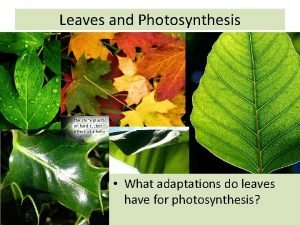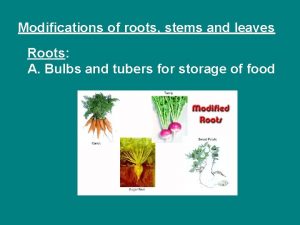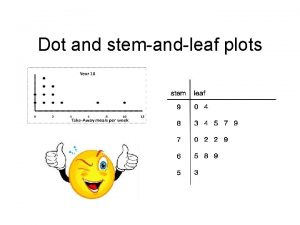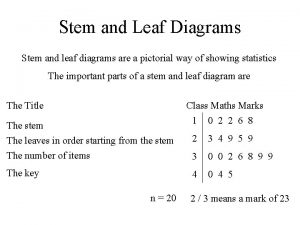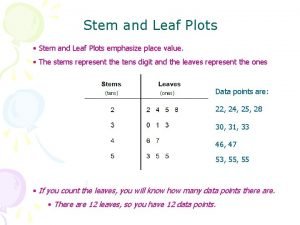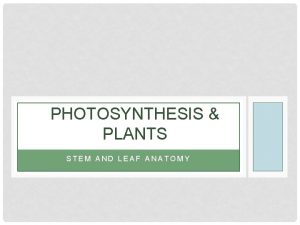Adaptations for Photosynthesis Leaf Stem and Root LEAF






- Slides: 6

Adaptations for Photosynthesis Leaf, Stem, and Root

LEAF 1. Large surface area allows for absorption of light energy* When you look at the outer surface of a leaf, what does it feel like, what does it look like? 2. 3. • • Epidermis- is covered by the cuticle (waxy layer), these structures protect the leaf from water loss, injury, and fungal attack. Stomates- are openings in the cuticle and epidermis Allows for exchange of carbon dioxide, oxygen, and water (regulates water loss) More on lower surface of leaf than upper surface Why would there be more stomates on the lower surface of the leaf as compared to the upper surface of the leaf? So that there is less of a chance that the leaf will dry up from losing too much water on the side that faces the sun!

Leaf (cont…) 4. • • 5. • • 6. • • • 7. • Guard Cells. Have chloroplasts Surround the stomata and regulate it’s opening and closing Palisade Layer. Consist of tall, tightly packed cells **HAVE MANY CHLOROPLASTS- MOST PHOTOSYNTHESIS OCCURS HERE Spongy Layer. Found below the palisade layer Has many air spaces-----> provides for exchange of gases and water vapor through the stomates Has chloroplasts, some photosynthesis occurs here Veins. Contains conducting (vascular) tissue

Stems What are the two types of vascular tissue? 1. Xylem- conducts water and minerals UP to sites of photosynthesis. 2. Phloem- conducts nutrients UP AND DOWN. Transpirational pull- when columns of water, extending from veins to stems to roots, are pulled upward as a result of transpiration (loss of water by evaporation) in the leaves. What common everyday item can you think of that works in the same way? A straw! • Stems support leaves • Stems have vascular tissue • Lenticels- are openings in stems which provide for gas exchange

Roots • • Roots anchor a plant They absorb water, and other dissolved nutrients in the soil • Roots have vascular tissue • Root hairs are tiny projections from the outer surface of the root. What do you think is the main function of the root hairs? 1. They increase surface area for absorption from soil into plant 2. Moist membranes of root hairs allow for gas exchange

Summary In which parts of a leaf are chloroplasts present? 1. Palisade layer 2. Spongy layer 3. Guard cells Where does most of photosynthesis occur in the leaf? 1. Palisade layer How do we know this? Because, it is the area in the leaf where we find the highest number, or concentration of chloroplasts.
